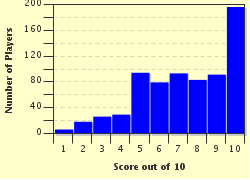Quiz Answer Key and Fun Facts
1. Romania is situated in Eastern Europe and shares land borders with five other sovereign countries. Which sea does it border?
2. Romania's terrain is almost equal areas of mountains, plains, and hills. The Carpathian Mountains snake through the country in an approximate J shape. Which peak is Romania's highest, situated in the Southern Carpathians?
3. Bucharest, Romania's capital, is the country's only city with a population exceeding 1 million. Upon which tributary of the Danube River does it stand?
4. The northernmost point of Romania is a village named Horodistea, which borders Ukraine. In which county is it situated, whose capital city is rich in culture, containing many museums and famous as the birthplace of Romanian historian and politician Nicolae Iorga?
5. Historically, Romania was divided into four regions. Although they are no longer relevant for administrative purposes, they are still generally known to the wider world, particularly Transylvania. Which of these is NOT one of the country's historical regions?
6. Romania and Ukraine disputed over the claim to an island close to the Danube delta. Named the White Island by the Greeks and Romans, it is named after which animal?
7. Which of these cities, situated in Transylvania and home to the Church of St. Michael, is one of the biggest in Romania? It stands upon the Somesul Mic river.
8. Romania is split into 41 counties, plus Bucharest, which has special administrative status. Which county, the country's westernmost, is the largest? It contains the city of Lugoj, where Bela Lugosi was born.
9. This city was founded under the name of Corona, and its German name is still currently Kronstadt (Crown City), while its coat of arms is topped by a crown. Which city is this, which staged a rebellion in 1987 against the policies of Nicolae Ceausescu?
10. What is the name of the gorge along Romania's border with Serbia, through which the Danube river passes? It is situated close to the port city of Orsova, and is an important source of hydroelectric power.
Source: Author
reeshy
This quiz was reviewed by FunTrivia editor
spanishliz before going online.
Any errors found in FunTrivia content are routinely corrected through our feedback system.
